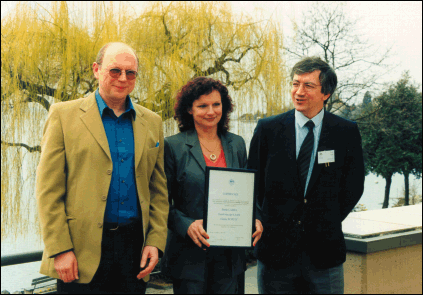Introduction
Previous Highlights covered the period from August through to July of the following year. This edition marks a change; the report now corresponds to the experiments done between August 1998 and December 1999, so that from now onwards the Highlights will be able to encompass a calendar year.
As usual some of the experimental results have not yet been fully analysed, and therefore some scientists are reluctant to expose details of their results before publication in a scientific journal. Consequently the articles presented here give only a partial view.
The availability of the machine reached 95.4% in 1999. Users operation with very low emittance (e HOR = 3.8 nm.rad and e VER = 10 pm.rad) has been tested for several weeks. The 1.6 metre in-vacuum undulator on beamline ID11 is delivering 2.1020 photons/s/mm²/mrad²/0.1%bw at 10 keV and still 1019 at 60 keV. In view of these results, some of the other beamlines are going to be equipped with 2 x 2 metre in-vacuum undulators. Additionally, it is interesting to note that the machine is able to reach e HOR = 1.7 nm.rad and e VER = 10 pm.rad with 100 mA and a lifetime of 31 hours.
The number of countries participating at the ESRF has increased recently. Portugal joined as associate member in 1998, Israel in 1999. The Czech Republic also joined in 1999 and will form a consortium with Hungary and Poland in July 2000.
Today the 30 public beamlines are in full operation. In addition, 10 CRG (Collaborating Research Groups) beamlines have been implemented and two more will start construction in 2000. If one adds the industrial beamline for microelectronics (MEDEA) and accounts for multiple end stations, this gives 52 simultaneous experiments instead of the 30 foreseen at the beginning of the ESRF.
The ESRF management is also pleased to report that Dr Paolo Carra (Theory group) has been awarded the Agilent Technologies Europhysics Award for the year 2000 in conjunction with Drs G. Schütz and G. van der Laan. This prestigious award (formerly known as the Hewlett Packard Europhysics Award) was awarded for the scientists' pioneering work in establishing the field of magnetic X-ray dichroism.
We would like to thank the ESRF staff and our users: their efforts have enabled us to obtain the results described in this report.
G. Admans, W.E.A. Davies, J.-M. Filhol, C. Kunz, P.F. Lindley, Y. Petroff
(May 2000)
 |
Pictured from left to right are G. van der Laan, G. Schütz and P. Carra after receiving the Agilent Technologies Europhysics Award. |



